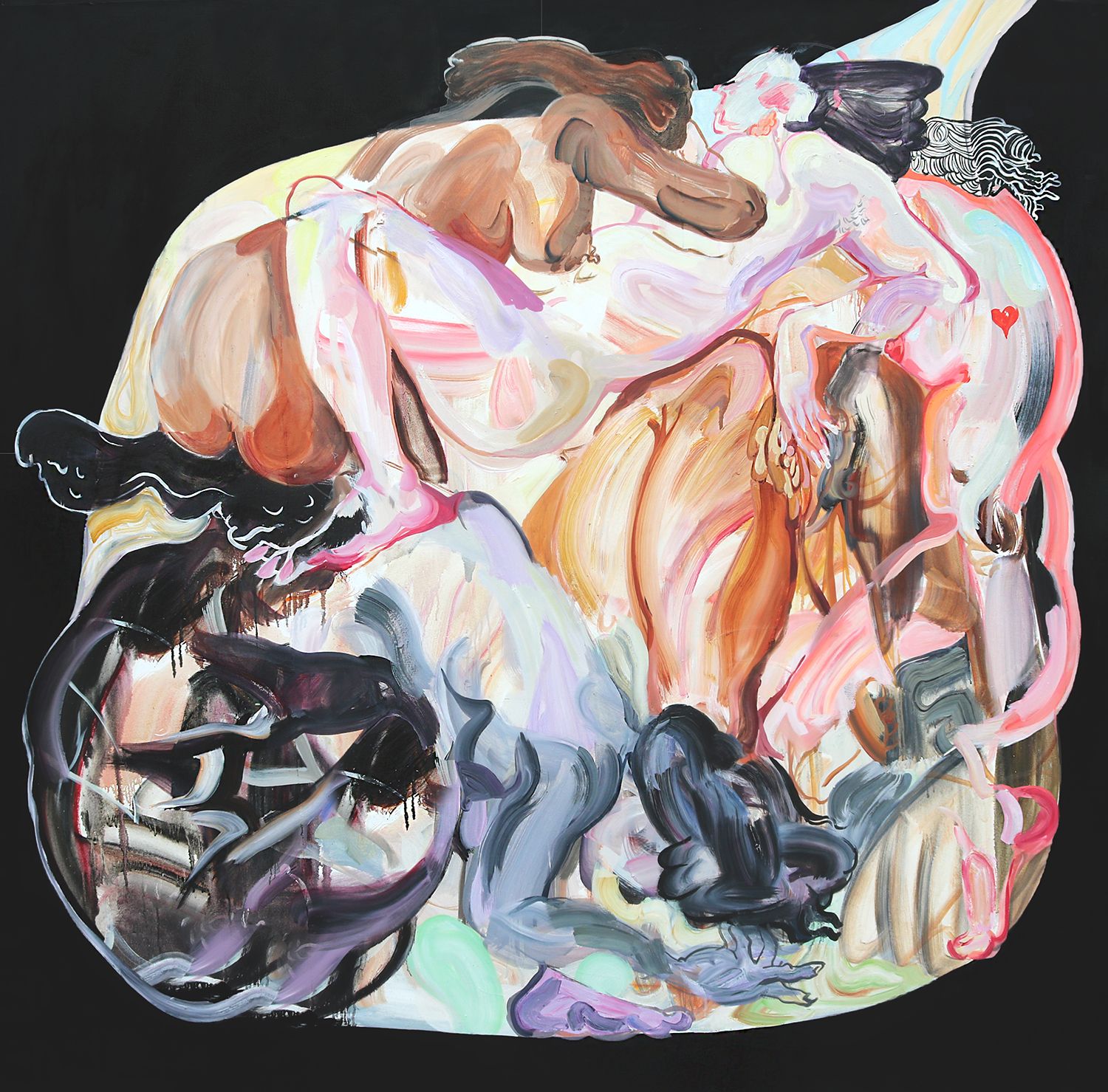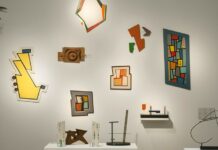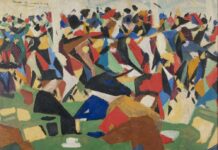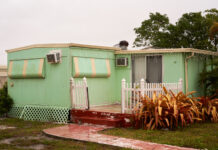Untitled Art Fairs
24 October 2022
An Interview with Wynnie Mynerva / Una entrevista con Wynnie Mynerva
By Ricky Amadour

This interview is available in both Spanish and English.
Peruvian-born, Lima-based artist Wynnie Mynerva is at the forefront of sexual expression, deconstructing gender constructs. Minerva, who is represented by LatchKey Gallery, develops site-specific installations and multi-person, participatory, action-based paintings as a form of building community. In this interview, we dive deep into the artist’s representations of the body and their views on dismantling repression associated with human sexuality.
RICKY AMADOUR: Nice to meet you. I wanted to get to know you more and ask you something straightforward. Where are you from and what was your first interest in painting and art?
WYNNIE MYNERVA: I was born in Lima, Peru. I feel it is important to mention the district where I was born, Villa El Salvador. Lima has different social strata and places of conflict, and Villa El Salvador is located on the outskirts of the city. From a very young age, I wanted to paint. I have painted and won contests since I was a child. I’ve had artistic talent since I was little, and they celebrated me for it. My family didn’t know precisely what art was, but they knew about painting more broadly. I wanted to be a painter and ended up a visual artist in a state-run public school in Lima.
RA: Your art is very personal and displays a lot of intimacy, especially with sexuality. What representations do you not see at the moment?
WM: I am interested in the representation of dissidence, the periphery, and aberrant bodies. Bodies that are not controlled, that are not consumed, that do not want to be consumed and do not allow themselves to be consumed. I think of representation as plural. I like to talk about the intimate because I fear taking someone else’s voice. In other words, I fear appropriating something, because paintings have that power. That’s one of maybe a few pros and cons. Sometimes the market can misrepresent the meaning of what one wants to say in a painting. So, in that sense, I like to talk about what is intimate so as not to talk about the other, not to speak about them from my perspective, which I ultimately think is reductive. What I articulate is a bit of life, of a society where I was born, grew up, and live in a society that, in the end, has condensed me and many people like me who come from similar circumstances. In that sense, I like to give my body to action painting, performance, and drawings to become a subject of experimentation and investigation.

RA: I am a non-binary person. I feel very comfortable viewing your work and feel like I can be part of that representation. How do you create empathy for diverse expressions?
WM: I am primarily interested in getting out of the heterosexual model. Getting away, for example, from genitals that “belong” to sexual identity and that are representative of a specific body. I was born a biological female and socialized as a biological female. When I started painting, I thought hard about how women are represented in painting and about changing the paradigm of women as consumables. Later on, when I stopped connecting with the idea of being a woman and began to identify as a non-binary person, the scope of my work expanded. I may look feminine, but I don’t have a vagina or want children; I’m not a biological woman. I recently had a relationship with a trans woman and like variety. The fluidity of concepts, of ceasing to abide by constructs, is something that interests me not only in art but in life.
RA:And how did you determine these ideas?
WM: By approaching my work through feminism, I attempted to leave behind the idea of identifying myself by my vagina to build my own vision of femininity and masculinity. But it didn’t work out. When I found out that you could be non-binary, I found myself.
RA: Is it to seek dignity?
WM: In my paintings, what I look for are social relationships. Seeing how bodies interact, become energy, become worthy vital forces. Not solely as a representation of the damaged body. It is an integral part of my work to talk about violence, but also as a gesture that dignifies the body somehow, showing power beyond the victim.
RA: You could say that your site-specific installations are celebratory events.
WM: My works, for example, are celebrations and parties. I like the idea of a party, a celebration, where the colors burst, where people live an event within the painting, which is something one may yearn for. It is not a place where someone says “poor thing,” but rather, where they can enjoy themselves. So, I feel it is in that dignity that I like to present my projects. Like an act of revenge, a feat, a triumph.
RA: I have close friends, especially in Colombia, who are along the same lines as you, including Olga Robayo from Residencia El Parche, Daniela Maldonado from La Red Communitaria Trans (The Trans Community Network), and Christian Howard Hooker from Corporación Colectivo CalleShortBus. In art, a new mentality is developing in how people represent themselves in society and how they oppose machismo, acting together against violence.
WM: There have been many particular instances of violence that made me want to touch on human trauma. For me, art is a form of therapy to talk about what continues as memory and pain. It is a constant drive. My projects, I’ve realized, are means to explore those other perspectives.


RA: Shall we say sex positivity?
WM: For example, about sex positivity. How do we use sex as a space for creativity and an ideological space? It is not only about having sex but as the general performance of our lives. We talk about the dominating and the dominated as the most basic power institutions of heterosexuality. They have moved into endless possibilities to do so, for example, from guilt or guilt in sex, or as good and evil, which is often rooted in religious tradition. For instance, in one of my exhibitions, I proposed El Jardín de las Delicias (The Garden of Earthly Delights), where people have sex inside latex bags. I wanted a garden where people could go to enjoy themselves. And the idea of having sex is a thing so common. We do it every day. Yet, it is so difficult to observe or know that it exists. The people who attended the room entered and could sense what was happening. People knew others were having sex inside the bags and had to live with that scene.
RA: And people stayed?
WM: They couldn’t get away from it because it was part of the exhibit, and I installed a big synthetic floor where visitors were invited to sit. They began to sit down, and a chimerical image occurred from one moment to another, almost dreamlike. People had their drinks and talked while they looked around at how people were having sex and at how others were reacting.
RA: You said you don’t see a difference between porn and classical art?
WM: The truth is, among erotic artists, I find no differences in the sense of image production. Both are sexual images. Let’s say there is a pictorial quality. I feel like it’s a class difference. Art puts elite or social classifying labels on us. I still can’t find a difference.
RA: How do you choose the people involved in your projects? And how can they participate?
WM: The truth is that I am constantly approached by people who want to dare to do something. By lawyers, doctors, engineers, and the baker who sells you bread. People want to live experiences. I invite them to my studio, and we talk to see if their intentions are serious. There are people from all walks of life. That also interests me in my work. The painting is like a stage, and they are like the actors; it’s super theatrical, dramatic, and I like that.
RA: Have you had confrontations from other people who don’t like what you’re doing or feel differently?
WM: Yes, during my first exhibition, El Otro Sexo (The Other Sex) which was presented in a language center. Children attended on Saturdays, so parents got together to close the presentation. It became a commotion of wanting to remove the actual sticks with their hands, and in the end, they canceled the show. It lasted less time. It has happened enough that there are people who write to me, persecute me, are disoriented because of the content I make, and threaten me, even in my artist community.
RA: What are your hopes, and how do you see the future?
WM: I feel that things are progressing very slowly. I think that my job is to try to touch the future, which I would like to enjoy, but will not see in the end. And so, for example, that’s why I had my operation, my sexual reassignment. That’s why I’ve done a lot of work that maybe, in some way, is like wanting to reach something; to touch the limits. I want people to see sexuality as a transgression, a form of taking over, accessible to play and enjoy.

Una entrevista con Wynnie Mynerva
Por Ricky Amadour
La artista Peruana radicada en Lima, representada por LatchKey Gallery, Wynnie Mynerva, está a la vanguardia de la expresión sexual, deconstruyendo construcciones de género. Mynerva desarrolla instalaciones específicas del sitio y pinturas basadas en la participación de varias personas como una forma de construir comunidad. En esta entrevista, profundizamos en las representaciones del cuerpo del artista y sus puntos de vista sobre el desmantelamiento de la represión asociada a la sexualidad humana.
RICKY AMADOUR: Mucho gusto. Quería conocerte más y preguntarte algo muy simple. ¿De dónde eres y cuál fue tu primer interés en la pintura y el arte?
WYNNIE MYNERVA: Yo nací en Lima, Perú. En Lima también siento que es importante mencionar el distrito donde nací, Villa El Salvador. Lima tiene diferentes estratos sociales, lugares de conflicto y digamos que Villa El Salvador es un lugar ubicado a la periferia o a los alrededores del centro de Lima, puede. Desde muy niña yo quería pintar. Soy de esos casos de que desde niña pintaba y ganaba concursos. Digamos un talento desde chiquita que me festejaban. No sabía exactamente lo que era el arte, pero sabía lo que era la pintura. Menos las artes visuales que son mucho más amplias. Y desde ahí me acuerdo mis honorarios de niña decían. O sea, quiero ser pintora, y terminé como artista visual en una escuela estatal pública de Lima.
RA: Siento que tu arte es muy personal y también tiene mucho de lo íntimo, especialmente con la sexualidad. ¿Cuáles representaciones que no ves en este momento?
WM: Me interesa ahora la representación de los cuerpos, la disidencia, la periferia, y cuerpos aberrantes en el buen sentido. Como los cuerpos que no están controlados, que no están consumidos, que no quieren ser consumidos y no se dejan ser consumidos. Pienso en la representación de lo plural. ¿Me gusta hablar de lo íntimo en el sentido que tengo mucho miedo tomar la voz de alguien más, no? O sea, de alguna forma, apropiarme de algo, de apropiarme de la compra o comercialización. Porque los cuadros, la pintura, tienen eso. ¿Eso es también uno de lo tal vez un algunos de los pros y los contras, no? A veces el mercado puede llegar a tergiversar el significado de lo que uno quiere decir en una pintura. Entonces, en ese sentido, me gusta hablar de lo íntimo para no hablar del otro, no para hablar desde mi propia mirada, que al fin y al cabo creo que reduce. De lo que habla es un poco de la vida, de una sociedad donde yo nací, crecí y vivo en una sociedad que al final me ha condensado y mucha gente como yo vengó para los procesos similares. En ese sentido, me gusta entregar mi cuerpo de acción en la pintura, en el performance, en dibujos, para ser un sujeto de experimentación, un sujeto de investigación.
RA: Yo soy una persona no binarie. Me siento muy cómodo cuando veo tu arte, me siento como que yo puedo ser parte de esa representación. ¿Cómo quieres crear empatía para las formas diversas en que representas?
WM: Me interesa primero salir del modelo heterosexual, como la representación, por ejemplo, de los genitales que pertenecen a una identidad sexual, que la representamos a un cuerpo específico. Yo nací como mujer biológica y me socialicé como mujer biológica. Cuando inicié mi trabajo de pintura tenía un fuerte rayo en pensar cómo la mujer se representa dentro de la pintura y cambiar ese paradigma de la mujer de consumo. Después fui ampliando ese ámbito cuando deje de conectarme con la idea de ser mujer. Me interesa ser una persona no binarie. O sea, me veo femenina, no tengo una vagina, no quiero tener hijos, no soy una mujer biológica como tal. Hace poco acabo de tener una relación con una mujer trans. Me gusta esa variedad. La fluidez de los conceptos, de dejar de estructurar los papeles, es algo que me interesa y no solamente en el arte, sino de la vida.
RA: ¿Y como te sentiste?
WM: Siento que a partir de corrientes como el feminismo, intenté dejar la idea de identificarme con mi vagina y construir mi propia idea de feminidad, masculinidad y transitar en esas vías y amplitudes. Pero no lo logré. Entonces, cuando se me presentó la idea del concepto de no binarie, me sentí totalmente dentro de elle.
RA: ¿Es para buscar una dignidad?
WM: Y en las pinturas ahora, actualmente lo que busco son relaciones sociales. Como los cuerpos interactúan, siendo energía, siendo fuerzas vitales dignas. No como una representación o solamente del cuerpo maltratado. Es una parte importante de mi trabajo hablar sobre la violencia, pero también una representación que dignifica de alguna forma, que muestra un poder más allá de la víctima.
RA: Se puede decir que tus instalaciones son eventos de festejar.
WM: Si, mis trabajos, por ejemplo, festejan, son unas fiestas. Me gusta mucho esa idea de ser una fiesta, una celebración, que los colores revienten, que la gente viva un suceso dentro de la pintura, que es algo que uno pueda añorar. No es algo que alguien diga “pobrecito”, sino más bien como elle está viviendo, elle está disfrutando. Entonces siento que es en esa dignidad, en cuál me gusta presentar mis proyectos. Como una revancha, una hazaña, pero ganada.
RA: Tengo amistades cercanas, especialmente en Colombia, que están por la misma corriente como Olga Robayo de Residencia El Parche, Daniela Maldonado de La Red Comunitaria Trans y Christian Howard Hooker de Corporación Colectivo CalleShortBus. Yo creo que entre el arte se está desarrollando una mentalidad nueva en cómo la gente se representa en sociedad y combate el machismo, para subirse todos contra la violencia.
WM: Hubo muchos episodios de violencia que me hicieron querer tocar el trauma humano. Y para mí el arte es una forma de terapia para hablar de aquello que todavía sigue como una memoria y de dolor, como una pulsión constante. Pero después, a través de mis proyectos, me di cuenta de que es un medio para explorar otras perspectivas.

RA: ¿Digamos el sexo libre?
WM: Por ejemplo, eso del sexo libre, como utilizar el sexo como un espacio de creatividad y un espacio ideológico también. No solamente se trata de tener relaciones sexuales, sino como el performance en general, de nuestras vidas. Mira, se habla de dominante y dominado como esas instituciones de poder más básicas de la heterosexualidad. Se han trasladado en un sinfín de posibilidades de hacerlo, por ejemplo, de la culpa, no la culpa en el sexo, como el bien y el mal, que es muchas veces arraigado de la tradición religiosa. Entonces siento que justo estaba pensando, últimamente hay alguna posibilidad de vivir fuera el pensamiento del bien y el mal. Por ejemplo, en una de mis exhibiciones propuse en El Jardín de las Delicias que la gente tuviera sexo dentro de la exhibición en bolsas de látex. No era sino en El Jardín de las Delicias, que en realidad lo que ella quiere es un jardín donde la gente vaya a disfrutar. Y la idea de tener sexo es una cosa tan común que lo hagas todos los días, pero tan difícil de observar o saber qué existe. La gente que asiste a la sala entraba y podía intuir lo que estaba sucediendo. Intuía que la gente sabía el sexo dentro de la bolsa y tenía que convivir con esa escena.
RA: ¿Y la gente se quedaba?
WM: No podían escapar de esa escena porque era parte de la exhibición y había puesto un piso de gran sintético donde invitaba a la gente a sentarse. Se empezaron a sentar y de un momento a otro sucedió una imagen quimérica, casi de sueños. La gente empezaba a tomar sus tragos y conversar mientras la gente miraba cómo alrededor estaba la gente teniendo sexo y los demás estaban.
RA: ¿Tú dijiste que no ves una diferencia entre la pornografía y el arte clásico?
WM: La verdad es que entre cualquier artista de arte erótico no encuentro diferencias en el sentido de producción de la imagen. Los dos son imágenes sexuales. Digamos que hay una calidad que es pictórica. Siento que es una diferencia de clases. El arte nos pone etiquetas de élite o de clases sociales. No encuentro todavía una diferencia.
RA: ¿Cómo escoges las personas que son como que participan en tus proyectos? ¿Y cómo pueden participar?
WM: La verdad es que siempre se me acerca gente qué quiere atreverse a hacer algo. Es importante, pero también al abogado, al doctor, al ingeniero, al panadero que te vende el pan, allá gente que realmente quiere vivir experiencias. Los cito a mi taller, hablamos un rato a ver si sus intenciones son serias. Y hay gente de todo, de todos los ámbitos. Eso me interesa también en mi trabajo. La pintura es como un escenario, son como los actores, súper teatral, la dramática, eso me gusta.
RA: ¿Has tenido confrontaciones de otras personas que no le gusta lo que estás haciendo o que se sienten de otra manera?
WM: Sí, la primera exhibición que yo tuve, El Otro Sexo, se presentó en un centro de idiomas y asistían niños los sábados, entonces los padres de familia se reunieron a querer cerrar la muestra. Se convirtió en un revuelo de querer sacarlas los palos con las manos y al final cancelaron la muestra. Duró menos tiempo. Ha pasado bastante que hay gente que me escribe, me persigue como gente que se desorienta, por el tipo de contenido que hago y me persigue o amenaza, o mi propio gremio artístico.
RA: ¿Cuáles son tus esperanzas y cómo vez el futuro?
WM: Yo siento que las cosas están avanzando muy lento, entonces pienso que mi trabajo tratar de tocar un poco el futuro, que me gustaría gozar, pero que no voy a ver al final. Y por eso. Por ejemplo. Por eso me hice mi operación, mi reasignación sexual. Por eso he hecho un montón de trabajos que tal vez de alguna forma es cómo querer alcanzar algo y tratar de tocar los límites. Quiero que la gente vea la sexualidad como eso, una transgresión, una forma de apropiarse, una forma de ser libre, y jugar y disfrutar en ella.
Amadour is an interdisciplinary artist who works with painting, sculpture, sound, and performance to investigate landscape, architectural forms, and our relationship as humans to built and natural environments. They received dual BA degrees in studio art and art history from the UCLA School of Arts and Architecture in 2018.
Amadour es un artista interdisciplinario que trabaja con pintura, escultura, sonido y performance para investigar el paisaje, las formas arquitectónicas y nuestra relación como seres humanos con los entornos construidos y naturales. Recibió una doble diploma en arte de estudio e historia del arte en la Escuela de Arte y Arquitectura de la UCLA en 2018.













